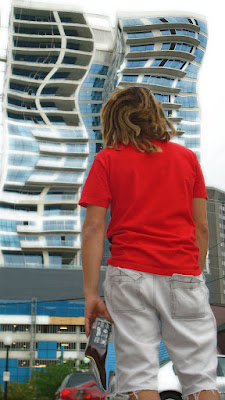The piece I constructed for this project combined two of the choices: using computed generated images along with the concept of a photo essay. This was not part of my planning, but something I stumbled upon as I began to shoot the photos. My original plan was to create a time lapse around a room, encircling my subject, who had taken pills similar to the concept in my new finished product. As I began this, however, I realized the difficulty of changing the same room about 20 different ways, and I started to feel that this did not depict a 'drug trip' as I had hoped too. I had shot the original pieces and attempted to alter them in photoshop, but I was unhappy with the results. On my walk home I looked up at the construction near my home, and I realized then what my project would now center on. The 'drug trip' would now be experienced in motion, as if the drug user set off on a journey to experience these new pills in the world rather than in his home. So, after one photo shoot, I grabbed my drug user again (in character only), and began this next round of shots starting first outside, to signify that the user was intent on taking this 'trip' around town.
The most exhilirating aspect of this second round of shots is that I only had one photo planned, the shot of him looking up at the large apartment building still under construction, also the shot that inspired this entire second round. I had vague ideas in my head of what some shots could look like, but did not know locations or how many I would take. We simply set out on a journy, trying to place ourselves in the minds of this drug user, attempting to discover what a fun 'trip' gone bad may lead him too. However, this gone bad aspect is something I came upon just after the shots in the alley (where the text 'fadeout' can be seen). This was the turning point of the shot. After this my intent was to show how this will not be such a happy ending. After wandering around the campus for a good amount of time, and tirelessly reviewing the photos I had on memory, I discovered that there were three stages of the 'trip' that had emerged in the photos. The first was the enjoyable experience, lasting until the 'fadeout' in the alley, the second was the questioning and paranoia, shown until the Alma mater shot, and the third being a spiritual awakening, culminating to the suicide in the last two photos. I feel as though these three parts compose three entirely different experiences and essays. On pg. 61 of Ways of Seeing, Berger talks of art confronting the user rather than us looking unto it, and these three different photo essays achieve this. I force the 'drug trip' experience onto the viewer, make them feel the experience, both the fun hallucinogenic aspects and the scary paranoia bits. This culminates into a spiritual experience, a 'walk into the light' as shown by one photo, that forces the viewer to understand what I wanted them to see in this experience, the power that these drugs have had over this man. All of this culminates into the final two photos, one of a jump over the ledge (which was a huge obstacle in photoshop) and the lifeless body on the ground. I attempted to make these images seem clear, but have an element of 'cartoon' to them. At first I just saw these images as appealing, sublime in how they charcterize his fated fall. But then I noticed that they took on this cartoon element, which reminded me of the McCloud piece which explained how cartoons and simplified images allow us to envision our self as the character drawn. This struck me as significant since this would make these last two images seem as though they could be you, the viewer. This essentially altered the entire aim of the photo essay, turing it more into an anti-drug ad than the experience of taking drugs. This was not at all my intent, but I feel I stumbled upon an effective anti-drug meaning to this piece.
The last part of the project that was a 'break-through' in a sense was the writing that is hidden and integrated into the last half of the project. This began when I put 'fadeout' into one image, and felt I could tell a story with the last tragic half of the story. The phrases are meant to explain what may be occuring in the mind of the subject while he is experiencing what is happening around him. None of these were envisioned while taking the photos, but were rendered when altering each image indepedently.








